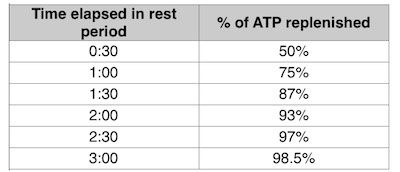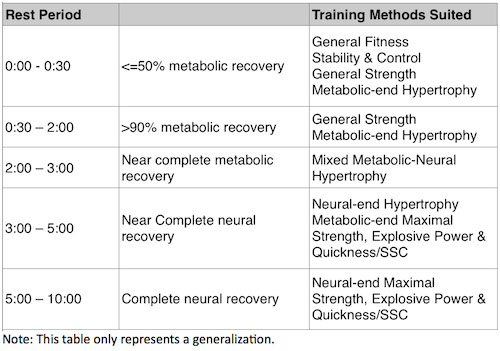Rest periods refers to the time between the completion of one set and the commencement of the next set.
Rest periods have a significant influence on the training effect. Shorter rest periods lean towards a metabolic effect while longer rest periods are more associated to a neural effect.
Issues determining rest periods
Metabolic recovery
Neural recovery
Work to rest ratios
Training age
Bodyweight
Metabolic recovery
An analysis of recovery from a metabolic perspective gives an insight into the rationale of using various period durations. The main source of metabolic energy in strength training is adenosine triphosphate (ATP), 50% of ATP is recovered in the first 30 seconds of rest, then 50% of the outstanding balance is recovered every subsequent 30 seconds.
 Recovery from a replacement of ATP perspective (King 2000)
Recovery from a replacement of ATP perspective (King 2000)
Note: This table only represents a generalization.
Neural recovery
Neural recovery may take up to 5-6 times longer to recover than metabolic recovery. This could take the rest period in excess of 10 minutes. The above table does not represent this fact, as there has not been as much ligature on this area as there has been for metabolic recovery.
Rest period length is vital during skill and/or explosive training. If rest periods are inadequate, fatigue will set in impeding the maximum neural drive for the following sets.
Work to rest ratios
Work to rest ratio needs to be taken into account. The duration of the set may be used to help determine the rest period. General belief in this area determines the work to rest ratio to 1:5 but this would be totally inadequate for neural recovery where a 1:60 ratio may be needed.
Training Age
Current literature suggests that those with a younger training age will require longer rest periods. As training age increases it is suggested that less rest is required, however other factors must be taken into consideration such as the fact that as training age increases the loading intensity will also increase placing an increased demand on the recovery ability of the individual.
Bodyweight
The bodyweight of the trainee may influence rest periods. Heavier trainees may require longer rest periods than that of their lighter counterparts. This may not be so much of a concern.
Repetitions and rest periods
There is an inverse relationship between reps and rest period. As illustrated below, the lower the reps, the longer the rest period. The higher the reps, the shorter the rest period required. There may be some variation in this due to the neural demand of the exercise being performed.
Rest period and training methods
As illustrated below the training method may determine the rest period used.
 Note: This table only represents a generalization.
Note: This table only represents a generalization.
Inadequate rest periods may result in the following
Progressive activation of alternate energy systems. I.e. Oxygen-independent glycolytic system (Lactic acid system), followed by the Oxygen-dependent system (aerobic energy system).
It should be noted that activation of the aerobic energy system encourages Glucocorticoid release (cortisol, cortisone, etc.) inhibiting or retarding amino acid incorporation into proteins; stimulates conversion of proteins into carbohydrates; maintains normal blood sugar level; conserves glucose; promotes metabolism of fat. These hormones are antagonistic to strength and hypertrophy development.
This is one reason why I do not promote the use of aerobic work in the same session as the anaerobic training session. And even to take it further to say that if the client does not specifically require aerobic conditioning I would remove any aerobic training from their program.
Inability to maintain optimal levels of muscle tension.
Altered recruitment of targeted muscle fibers.
When targeting type I, II A fibers, inadequate rest will force recruitment of type II B and reserve fibers in attempt to continue work demand.
When targeting II B fibers, inadequate rest will result in forced recruitment of II A, and eventually type I fibers. This will significantly affect speed of movement, strength, and muscle tension.
Neural fatigue and associated regression of motor skills.
Accumulation of metabolic waste.
Psychological fatigue.
Too much rest between sets may result in the following
Loss of body temperature, causing a need to warm up again.
Loss of nervous system facilitation/stimulation, often resulting in decreased performance in the following set.
Increased likelihood of injury after prolonged rest periods.
- Longer Interset Rest Periods Enhance Muscle Strength and Hypertrophy in Resistance-Trained Men: Schoenfeld, Brad J.; Pope, Zachary K.; Benik, Franklin M.; Hester, Garrett M.; Sellers, John; Nooner, Josh L.; Schnaiter, Jessica A.; Bond-Williams, Katherine E.; Carter, Adrian S.; Ross, Corbin L.; Just, Brandon L.; Henselmans, Menno; Krieger, James W. The Journal of Strength and Conditioning Research. 2016.
- The effects of short versus long inter-set rest intervals in resistance training on measures of muscle hypertrophy: A systematic review: Grgic, Jozo; Lazinica, Bruno; Mikulic, Pavle; Krieger, James W.; Schoenfeld, Brad Jon. European Journal of Sport Science. 2017
- Effects of Rest Interval Duration in Resistance Training on Measures of Muscular Strength: A Systematic Review: Grgic, Jozo; Schoenfeld, Brad J.; Skrepnik, Mislav; Davies, Timothy B.; Mikulic, Pavle. Sports Medicine. 2017.
- Variability and Impact of Self-Selected Interset Rest Periods During Experienced Strength Training: Ibbott, P.; Ball, N.; Welvaert, M.; Thompson, K. G. Perceptual and Motor Skills. 2019.
- Acute effects of shorter but more frequent rest periods on mechanical and perceptual fatigue during a weightlifting derivative at different loads in strength-trained men: Jukic, Ivan; Tufano, James J. Sports Biomechanics. 2020.
